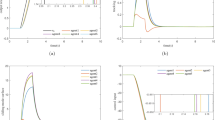Abstract
This paper derives and analyzes a new robust fuzzy-logic sliding-mode controller of the diagonal type, which does not need the prior design of the rule base. The basic objective of the controller is to keep the system on the sliding surface so as to ensure the asympotic stability of the closed-loop system. The control law consists of two rules: (i) IF sign(e(t)ė(t)) < 0 THEN maintain the control action, and (ii) IF sign(e(t)ė(t)) > 0 THEN change the control action, where e(t) = x(t) − xd(t) is the system state error, and the control action can be either an increase or decrease of the control signal, which is realized through the use of fuzzy rules. The proposed controller, which does not need the prior knowledge of the system model and the prior design of the membership functions" shape, was tested, by simulation, on linear and nonlinear systems. The performance was in all cases excellent (very fast trajectory tracking, no chattering) . Of course, as in traditional control, there was a trade-off between the rise-time and the overshoot of the system response.
Similar content being viewed by others
References
Arimoto, S.: Learning control theory for robotic motion, Internat. J. Adaptive Control Signal Processing 4 (1990), 543–564.
Cox, E.: The Fuzzy System Handbook, Academic Press, New York, 1994.
Doumanidis, C. and Hardt, D. E.: A model for in-process control of thermal properties during welding, ASME J. Dyn. Systems Meas. Control 111 (1989), 40–50.
Jamshidi, M.: Large Scale Systems: Modelling, Control and Fuzzy Logic, Prentice-Hall, Englewood Cliffs, NJ, 1997.
Kosko, B.: Neural Networks and Fuzzy Systems: A Dynamical Systems Approach to Machine Intelligence, Prentice-Hall, Englewood Cliffs, NJ, 1992.
Li, W.: A method for design of a hybrid neuro-fuzzy control system based on behavior modeling, IEEE Trans. Fuzzy Systems 5(1) (1997), 128–137.
Liand, H. and Gatland, H. B.: Conventional fuzzy control and its enhancement, IEEE Trans. Systems Man Cybernet. 26(5) (1996), 791–801.
Lin, C. T.: Neural Fuzzy Control Systems with Structure and Parameter Learning, World Scientific, Singapore/London, 1994.
Lin, S. C. and Kung, C. C.: Linguistic fuzzy sliding mode controller, in: Proc. of 1992 Amer. Control Conf., Chicago, IL, pp. 1904–1905.
Malki, H. A., Li, H., and Chen, G.: New design and stability analysis of fuzzy proportional-derivative control systems, IEEE Trans. Fuzzy Systems 4(4) (1994), 245–254.
Malki, H., Misir, D., Feigenspan, D., and Chen, G.:Fuzzy PID control of a flexible-joint robot arm with uncertainties from time-varying loads, IEEE Trans. Control Systems Technol. 5(3) (1997), 371–378.
Nie, J. and Linkens, D.: Fuzzy-Neural Control: Principles, Algorithms and Applications, Prentice-Hall, Englewood Cliffs, NJ, 1995, pp. 69–86.
Nishar, D. V., Schiano, J. L., Perkins, W. R., and Weber, R. A.: Adaptive Control of Temperature in Arc-Welding, IEEE Control Systems Magaz. (1994), 4–12.
Palm, R., Driankov, D., and Hellendoorn, H.: Model-Based Fuzzy Control, Springer, Berlin, 1996, pp. 75–113.
Pieper, J. K. and Goheen, K. R.: Discrete–time sliding mode control via input–output models, in: Proc. of Amer. Control Conf., San Fransisco, CA, 1993, pp. 964–965.
Slotine, J. E. and Li, W.: Applied Nonlinear Control, Prentice-Hall, Englewood Cliffs, NJ, 1991.
Tzafestas, S. G.: Digital PID and self-tuning control, in: S. G. Tzafestas (ed.), Applied Digital Control, North-Holland, Amsterdam, 1985, pp. 1–49.
Tzafestas, S. G., Kyriannakis, E., and Rigatos, G.: Adaptive, model-based predictive and neural control of the welding process, in: S. G. Tzafestas (ed.), Methods and Applications of Intelligent Control, Kluwer, Dordrecht/Boston, 1997, pp. 509–548.
Tzafestas, S. G. and Papanikolopoulos, N. P.: Incremental fuzzy expert PID control, IEEE Trans. Industr. Electronics 37(5) (1990), 365–371.
Tzafestas, S. G. and Rigatos, G. G.: Self-tuning multivariable fuzzy and neural control using genetic algorithms, in: Proc. of DSI ‘99 Internat. Conf., Athens, Greece, 1999.
Tzafestas, S. G. and Tzafestas, C. S.: Fuzzy and neural control: Basic principles and architectures, in: S. G. Tzafestas (ed.), Methods and Applications of Intelligent Control, Kluwer, Dordrecht/Boston, 1997, pp. 25–60.
Tzafestas, S. G., Tzamtzi, M. P., and Rigatos, G. G.: Robust control and motion design for mobile robots in a time-varying environment, in: CESA ‘96 IMACS Multiconference Proc., Lille, France, July 1996, pp. 706–712.
Wang, L. X.: Adaptive Fuzzy Systems and Control: Design and Stability Analysis, Prentice-Hall, Englewood Cliffs, NJ, 1994, pp. 9–28.
Wu, J. C. and Liu, T. S.: A sliding-mode approach to fuzzy control design, IEEE Trans. Control Systems Technol. 4(2) (1996), 141–151.
Author information
Authors and Affiliations
Rights and permissions
About this article
Cite this article
Tzafestas, S.G., Rigatos, G.G. A Simple Robust Sliding-Mode Fuzzy-Logic Controller of the Diagonal Type. Journal of Intelligent and Robotic Systems 26, 353–388 (1999). https://doi.org/10.1023/A:1008161815798
Issue Date:
DOI: https://doi.org/10.1023/A:1008161815798




